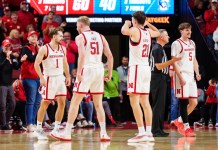College Basketball
For those of you familiar with my preseason college football work, some of the key pieces surround what I call “transitional systems.” These systems project whether or not teams will improve or decline based upon a variety of factors, ranging from key statistics, number of returning starters, coaching changes, and several other variables. I even have a popular system I employ yearly to quantify my theories, called Stability Scores.
I do this every summer to prep for a new season, as one of the most difficult things about handicapping college sports is the process of evaluating teams from one season to the next. So many things can affect a team’s strength and/or how different they might be. Adding to the difficulty is the thought that many programs are taking players out of their most recent recruiting class and/or the transfer portal and plugging them into early starting spots. For the 2024-25 season, 39 teams across the country bring back 10% or less of their player minutes from last season. Essentially, these teams are starting from scratch.
I have a similar set of ideals in predicting potential teams that might improve or decline in the coming season for college basketball. They’re based upon shared characteristics of past teams fitting that bill. Identifying those teams accurately can help build bankrolls. In 2022-23, the list of teams to watch for performed amazingly, as all 21 of the teams I projected to decline last year did so, and 20 of the 23 teams I projected to get better that season saw their records improve year-over-year.
Last year, 23 of the 26 teams that made the likely decline list did exactly that, winning 5.5 fewer games on average. On the opposite side, 11 of the 14 likely improved teams followed through. I share the details of those projections from last year below, which are highlighted in gray. It was the third straight season in which I saw noteworthy returns on this strategy, so I have decided to employ it again.
Any of you who have become regular readers of my work know that I rely heavily on systematic approaches that exhibit a solid foundation for year-after-year repeated success. I strongly believe that returning experience or lack thereof, and the relationship of that with how a team fared in the prior season in various analytics, is a huge foundational cornerstone on which bettors should analyze teams going into a college basketball season. What I have put together below is based wholly on that logic.
Shared Characteristics of Teams that Decline Year-to-Year
There have been 120 teams over the last nine seasons that have declined by 30% or more (approximately 15 wins) from one year to the next in terms of outright won-lost percentage. Do these teams share personnel or statistical characteristics that might help us project the potential depreciating teams for this season? Let’s take a look, using a similar process I employ in projecting the title favorites and potential Cinderella teams for the NCAA Tournament each March.
Of the 120 teams I described above, to narrow down the list of this year’s qualifying teams:
– About 2/3 of them won 60% or more of their games in the prior season (125 teams did this in 2023-24)
– 83, or about 69.2%, had two or fewer returning starters (84 of the 125 teams for this season have this)
– About 2/3 of them had less than 50% RPM (returning player minutes) back for that season (73 of the 84 teams for this season share this trait)
Note: I have made a big adjustment to the qualifiers for bullet point #3 after going back and reassessing the numbers. The RPM benchmark used to be 30% or less. It is now less than 50%. This has expanded our list of teams greatly, thus giving bettors more teams to go against.
With a list of 73 potential teams destined to fall off in 2024-25, I then analyzed seven different statistical angles from the prior season, matching the 120 teams from past years that experienced 30%-plus declines in win percentage:
– About 2/3 of them had a point differential of less than +6.5 PPG in the prior season
– About 2/3 of them won 50% or more of their games ATS in the prior season
– About 2/3 of them had at least five close wins in the prior season (<=5 PTS)
– About 2/3 of them had at most four close losses in the prior season (<=5 PTS)
– About 2/3 of them had five or fewer blowout wins in the prior season (>=20 PTS)
– About 2/3 of them had at least one blowout loss in the prior season (>=20 PTS)
– About 2/3 of them won seven or fewer of their last 10 games in the prior season
Here is the list of the 73 teams with the number of traits they match from above (out of seven). It could be assumed that the more shared traits, the greater chance that the team declines significantly in 2024-25, although, as you’ll see just below this year’s list, there was a consistent decline from all the teams last year. Note that the teams marked with a “*” have new head coaches this season:
* DUQUESNE (7)
OAKLAND (7)
BELMONT (6)
COLGATE (6)
LIPSCOMB (6)
MONTANA (6)
SOUTH CAROLINA (6)
SOUTH FLORIDA (6)
STETSON (6)
TARLETON STATE (6)
* TENNESSEE-MARTIN (6)
UNLV (6)
ARK-LITTLE ROCK (5)
BRYANT (5)
CHARLOTTE (5)
* DRAKE (5)
HOFSTRA (5)
ILLINOIS (5)
* JAMES MADISON (5)
MEMPHIS (5)
NC STATE (5)
PROVIDENCE (5)
RICHMOND (5)
SOUTH DAKOTA STATE (5)
SETON HALL (5)
ST BONAVENTURE (5)
SYRACUSE (5)
TOLEDO (5)
UNC-ASHEVILLE (5)
* VIRGINIA (5)
* WASHINGTON STATE (5)
APPALACHIAN STATE (4)
COLORADO (4)
FAIRFIELD (4)
GEORGE MASON (4)
* INDIANA STATE (4)
LONGWOOD (4)
OHIO STATE (4)
SAMFORD (4)
UNC-GREENSBORO (4)
UT-CHATTANOOGA (4)
WESTERN ILLINOIS (4)
WISCONSIN (4)
AKRON (3)
ARIZONA (3)
BAYLOR (3)
BOISE STATE (3)
CAL SAN DIEGO (3)
* COLLEGE OF CHARLESTON (3)
CONNECTICUT (3)
DREXEL (3)
MISSISSIPPI STATE (3)
* MOREHEAD STATE (3)
NEW MEXICO (3)
SEATTLE (3)
TENNESSEE (3)
TEXAS TECH (3)
UNC-WILMINGTON (3)
* WESTERN CAROLINA (3)
* YOUNGSTOWN STATE (3)
* BYU (2)
* FLORIDA ATLANTIC (2)
* KENTUCKY (2)
OKLAHOMA (2)
SAN DIEGO STATE (2)
TCU (2)
DUKE (1)
LOUISIANA TECH (1)
MASSACHUSETTS (1)
ST JOHN’S (1)
ST THOMAS-MN (1)
TEXAS (1)
Here is a look back at the 2022-23 to 2023-24 results. Overall, 23 of the 26 teams declined, by an average of 6.1 wins on the season or a little over 20% on winning percentage. The eight teams that dropped after bringing in new head coaches dropped by an average of 7.9 wins:
*NORTHWESTERN STATE (7) – fell from 22-11 to 9-23
SANTA CLARA (7) – fell from 23-10 to 20-13
*GEORGE MASON (6) – went from 20-13 to 20-12
INDIANA (6) – fell from 23-12 to 19-14
KANSAS STATE (6) – fell from 28-8 to 23-11
*PENN STATE (6) – fell from 23-14 to 16-17
ARIZONA STATE (5) – fell from 23-13 to 14-18
BALL STATE (5) – fell from 20-12 to 15-16
MONTANA STATE (5) – fell from 25-10 to 17-18
*SOUTHERN UTAH (5) – fell from 24-13 to 10-21
TOWSON STATE (5) – fell from 21-12 to 20-14
ALABAMA (4) – fell from 31-6 to 25-12
CINCINNATI (4) – fell from 23-13 to 22-15
*VIRGINIA COMMONWEALTH (4) – fell from 27-8 to 24-14
VIRGINIA (4) – fell from 25-8 to 23-11
GONZAGA (3) – fell from 31-6 to 27-8
*IONA (3) – fell from 27-8 to 16-17
KENTUCKY (3) – went from 22-12 to 23-10
MEMPHIS (3) – fell from 26-9 to 22-10
*TEXAS A&M CC (3) – fell from 24-11 to 21-12
*UTAH STATE (3) – went from 26-9 to 28-7
*UTAH VALLEY STATE (3) – fell from 28-9 to 16-16
XAVIER (3) – fell from 27-10 to 16-18
YOUNGSTOWN STATE (3) – fell from 24-10 to 22-10
NC CENTRAL (2) – fell from 18-12 to 18-13
UCLA (2) – fell from 31-6 to 16-17
In addition, a noteworthy 29 of the 120 (24.2%) teams had a new head coach, a lofty number considering the normal percentage of new coaches is 13%. The average SU win percentage drop for this group has been 36.9%! For 2024-25, as denoted above, nine teams find themselves in that dangerous predicament: BYU, College Of Charleston, Drake, Duquesne, Florida Atlantic, Indiana State, James Madison, Kentucky, Morehead State, Tennessee-Martin, Virginia, Western Carolina, Washington State, Youngstown State.
Shared Characteristics of Teams that Improve Year-to-Year
There have been 126 teams over the last nine seasons that have improved by 28% or more (approximately 10 wins) from one year to the next in terms of outright won-lost percentage. Do these teams share personnel or statistical characteristics that might help us project the potentially upgraded teams for this season? Let’s take a look.
Of the 126 teams I described above, to narrow down the list of this year’s qualifying teams:
– About 2/3 of them won less than 37% of their games in the prior season (68 teams did this in 2023-24)
– 90 of them, or 71%, had three or more returning starters (15 of the 68 teams for 2024-25 have this)
– About 2/3 of them had 50% RPM or more (11 of the 15 teams have this)
– Automatically eliminate any teams with new head coaches (this eliminates one team for 2024-25, William & Mary)
With a trimmed-down list of 10 potential teams destined to improve in 2024-25, I again analyzed seven more statistical angles from the prior season, matching the 126 teams from past years that experienced 28%-plus gains in win percentage:
– About 2/3 of them had a point differential of better than -6.0 PPG in the prior season
– About 2/3 of them won 50% or less of their games ATS in the prior season
– About 2/3 of them had four or fewer close wins in the prior season (<=5 PTS)
– About 2/3 of them had at least five close losses in the prior season (<=5 PTS)
– About 2/3 of them had at least two blowout wins in the prior season (>=20 PTS)
– About 2/3 of them had four or fewer blowout losses in the prior season (>=20 PTS)
– About 2/3 of them won three or more of their last 10 games in the prior season
Here is the list of the 10 teams with the number of traits they match from above (out of 7). Again, it could be projected that the more shared traits, the greater the chance that the team will improve significantly in 2024-25:
ARMY (6)
LAFAYETTE (6)
AIR FORCE (4)
CHARLESTON SO (4)
MD-BALT COUNTY (4)
MORGAN STATE (4)
DARTMOUTH (2)
HOLY CROSS (2)
N CAROLINA A&T (2)
ST FRANCIS-PA (2)
The big takeaway from the “likely improvement” list is that it is shrinking more and more every year, as, unfortunately, the growing transfer portal is making it impossible for teams to improve by retaining talent. In fact, for the first time since I started doing this, not a single power conference team appeared. I imagine this could be the last year I can even use this methodology before reinventing a strategy. In the same way, the likely decline list continues to expand annually.
Here is a look back at the 2022-23 to 2023-24 results from this same study. Overall, 11 of the 14 teams improved, after 20 of 23 did the prior season. The average win bump for those that did get better was 6.5 on the season or a little over 17% on winning percentage. The outliers are in italics:
CENTRAL CONN STATE (5) – climbed from 10-22 to 20-11
ILLINOIS STATE (5) – climbed from 11-21 to 15-17
LAMAR (5) – climbed from 9-22 to 19-14
LOYOLA (IL) (5) – climbed from 10-21 to 23-10
LOYOLA (MD) (5) – fell from 13-20 to 7-25
NEW ORLEANS (5) – fell from 12-20 to 10-23
COLUMBIA (4) – climbed from 7-22 to 13-14
DARTMOUTH (4) – fell from 10-18 to 6-21
CHICAGO STATE (3) – climbed from 11-20 to 13-19
MARIST (3) – climbed from 13-20 to 18-13
NORTH DAKOTA (3) – climbed from 13-20 to 18-14
DELAWARE STATE (2) – climbed from 6-24 to 15-19
NEBRASKA-OMAHA (2) – climbed from 9-23 to 15-18
OREGON STATE (2) – climbed from 11-21 to 13-19
Use this information in conjunction with the analysis of VSiN’s college hoops experts to build your own list of play on and/or against teams for 2024-25.






